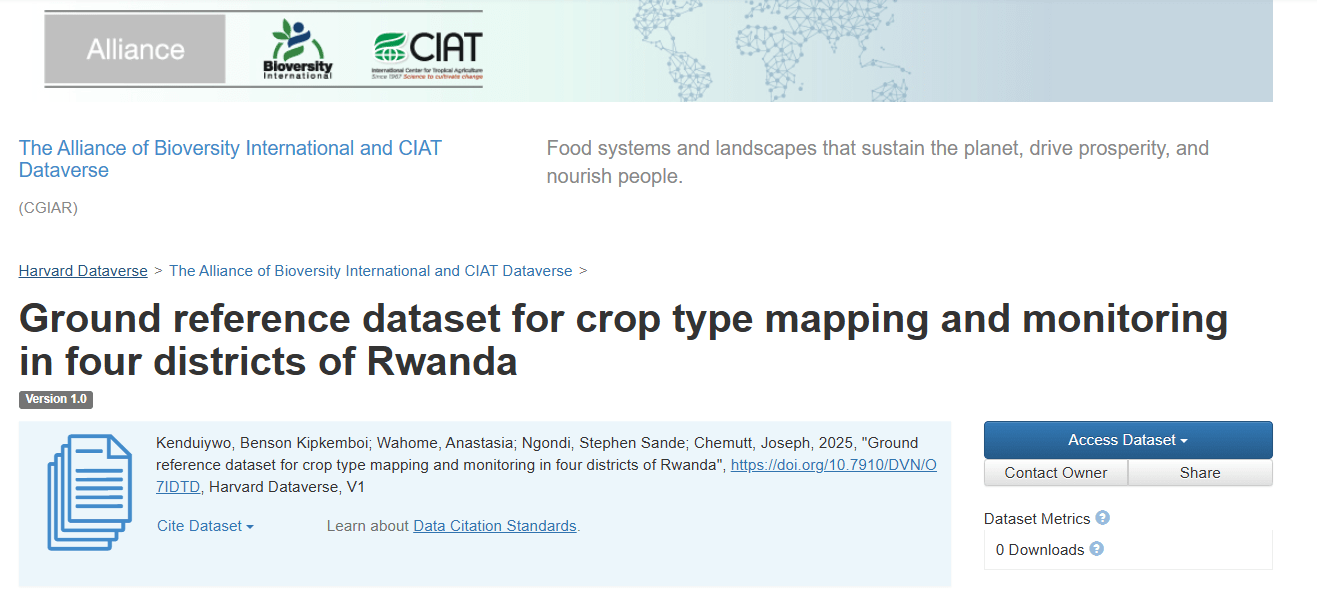The Intergovernmental Panel on Climate Change reports highlights that food security in East Africa continues to be undermined by climate-induced variability, progressive land degradation and biodiversity loss, and insufficient, unreliable agricultural statistics for effective policy and planning. However, remote sensing offers transformative potential to strengthen food security through real-time data provision that is key for crop monitoring. A critical prerequisite for remote sensing–based crop mapping, however, is the availability of high-quality labelled ground reference data to train and validate Artificial Intelligence (AI) classification models. Consequently, the Deutsche Gesellschaft für Internationale Zusammenarbeit (GIZ), in collaboration with Rwandas’ Ministry of Agriculture and Animal Resources and the Rwanda Space Agency, supported a pilot initiative to develop an automated AI-driven approach for within-season crop monitoring. Through this initiative the Alliance of Bioversity International and the International Center for Tropical Agriculture (CIAT), as grant implementers, collected ground reference data between 6 May and 7 June 2025 across four pilot districts in Rwanda—Nyagatare, Musanze, Nyabihu, and Ruhango. These districts, recognized as consolidated cropland “food basket” areas, are vital to national food security. The survey focused on four priority crops under Rwanda’s Crop Intensification Programme—maize, beans, rice, and Irish potato.
The data collection captured comprehensive information on farm location (administrative units from province down to village level), plot characteristics (size, number, erosion control, and agroforestry practices) and crop attributes (cropping system, crop type, planting date, growth stage, yields, seed variety, fertilizer use and presence of fruit trees). Additional data include management practices such as weeding, water sources and harvesting methods, complemented by spatial references (GPS coordinates and directional photographs). This dataset provides both spatial and agronomic insights into Rwanda’s farming systems. The reference points and associated photographs supported the digitization and labelling of polygons used to train and validate the AI-based crop type classification framework. The final dataset—comprising georeferenced points, annotated attributes and labelled polygons—is shared as an open resource to advance crop monitoring in Rwanda.
Methodology:Primary ground reference crop type information was collected using smartphones and tablets equipped with structured questionnaires developed and deployed on the KoboToolbox platform. The questionnaires were designed to capture both geospatial and contextual farm-level information relevant to crop mapping and classification. Trained enumerators were engaged to conduct the fieldwork. Each enumerator downloaded and configured the KoboToolbox Android application on their devices to access digital survey forms and to submit collected data directly to a central server. Prior to field deployment, enumerators were provided with sampled geolocations to be visited during the survey.
The sampled locations were derived using stratified random sampling from crop-type maps generated through a transfer learning approach. Sampling was constrained to 1 km buffers around trunk, primary, secondary, and tertiary roads to ensure ease of accessibility during field surveys and at least 100 m for each other per crop type. This ensured that the majority of the target points represented cultivated areas with the crops of interest—namely beans, Irish potato, maize, and rice with access considerations. Enumerators used Google Maps for navigation to reach the designated sampled points. Upon arrival at each location, they systematically captured geospatial and contextual information namely: administrative identifiers (e.g., county, sub-county, ward), farm plot characteristics (size, boundaries, land use), crop types present, farming system details, GPS coordinates of the plot and photographs of the four cardinal directions. In cases where enumerators could not locate any of the crops of interest at the sampled point, they were instructed to identify and survey a nearby farm with the required crop. Similarly, when access to a sampled location was restricted—due to factors such as heavy rains, flooding, or other physical barriers—enumerators were permitted to shift to the nearest accessible location with the target crop type.
Kenduiywo, B.K.; Wahome, A.M.; Sande, S.N.; Chemutt, J.K.

